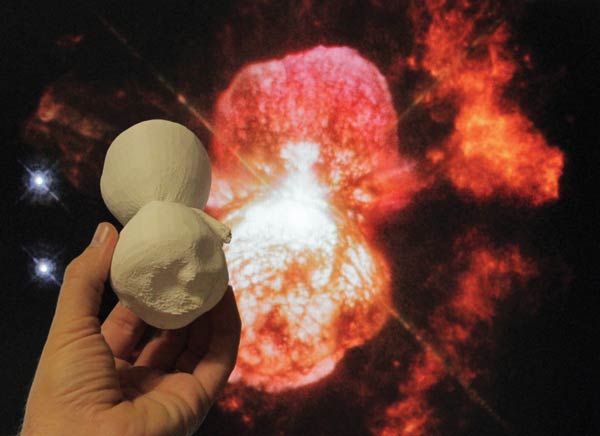Astronomy for a Better World
Fall
2014
Feature
Astronomy for a Better World
Kevin Govender, Director, International Astronomical Union Office of Astronomy for Development, Cape Town, South Africa

To many people the words “astronomy” and “development” simply don’t belong together. The former conjures up images of celestial beauty and the grandeur of our evidence-based imaginations, while the latter brings us down to Earth, to the poverty-ridden, disease-ridden, conflict-ridden society of which we are very much a part. That one should impact the other is sometimes a contentious issue. Why invest in astronomy when people are starving? Why invest in any “blue-skies” science for that matter?
In 2009 the International Astronomical Union (IAU) took the bold and visionary step of ratifying a strategic plan that aimed to use astronomy to stimulate global development. IAU, the largest body of professional astronomers in the world, is a global voice in astronomy with a mission “to promote and safeguard the science of astronomy in all its aspects through international cooperation.” At the core of the IAU’s new plan was the establishment of an Office of Astronomy for Development (OAD), inaugurated in 2011 in Cape Town, South Africa, and hosted at the South African Astronomical Observatory. Since then, new regional offices have been established in China, Thailand, and Zambia.
Our vision is simple and broad: “Astronomy for a better world!” Astronomy has close ties to three key areas that contribute to development. The first is technology, from the construction of telescopes to projects that push the limits of our data handling abilities. The second is science, since exploring the universe requires interdisciplinary approaches that stimulate diverse fields from physics to chemistry to biology. The third is culture; across the world, societies have profound cultural connections to the cosmos that include deep questions such as whether there is life “out there.” We aim to use these characteristics of astronomy for the benefit of society at large.
Because of its cross-cutting nature, astronomy can inspire thought and stimulate problem-solving skills at all levels from cradle to grave. OAD activities are therefore shaped around three target groups: universities and research; children and schools; and the general public. Through an annual open call for proposals, the OAD seeks innovative ideas that reach out to these groups and use astronomy to stimulate education and development.
One project we recently funded, “Astronomy for the Visually Impaired,” distributed innovative tactile models that brought astronomy to the visually impaired in about 30 countries. We hosted Wanda Diaz-Merced, a blind Puerto Rican astronomer, at the OAD for two months. She taught us about astronomy tools that are useful for visually impaired learners, including 3D-printed models and NASA’s Radio JOVE, a radio astronomy kit. We visited schools where blind learners were given tactile models of the Sun, Moon, and Earth to literally get a feel for astronomy. The reactions were incredible. As Diaz-Merced put it, “Good questions arose from every corner of the room after our presentations. The children asked, asked, asked!” While at the OAD she also gave an inspiring TEDx talk, available online at at http://tedxtalks.ted.com/video/Listen-to-the-Stars-Wanda-L-Dia.
In total we have funded 41 projects over the years, reaching out to over 40 countries. “Astrolab” (a three-year project) seeks to develop a virtual telescope control room that accesses robotic telescopes remotely from university physics departments. “Astronomy for the Extremely Ill or Traumatically Injured Children and Their Families” uses the inspirational power of astronomy to lift the spirits of children and their families at Ronald McDonald Houses in the United States. Regular updates on all these projects are posted on the OAD website.
The door remains open for innovative ideas that can be funded with seed money and subsequently incubated at the OAD. We currently face overwhelming demand for a limited pool of funding. (Only 10 percent of potential projects were funded in 2013.) OAD has been trying out new forms of fundraising, from crowdfunding to forming in-kind partnerships with organizations involved in similar activities.
Opportunities to engage with the OAD range from volunteering to internships to visiting fellowships. We also have an open “to-do list” online, with ideas that we think would be great to implement but for which we don’t have the staffing—such as developing a platform to crowdsource English proofreading for scientific papers that are written by authors who did not learn English as their first language.
More information on the OAD and various opportunities to get involved can be found on www.astro4dev.org.



